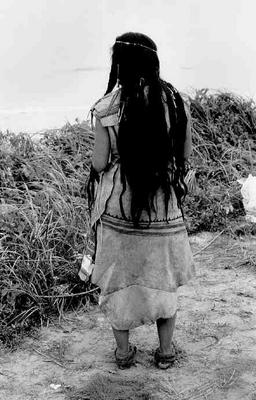

Mikmaq Woman as in 1400's - courtesy of Mike Price, private collection
![]()
|
Researching your indigenous roots may be
emotionally challenging regardless of your real motivations for doing so.
You may wish to gain tribal membership, find lost relatives or just hope
to learn more about your cultureal heritage. There are many paths you will
need to take, but if you have the patience, you will achieve your
goals.
Before starting your research, you will need to be familiar with some recognized terms.
Beginning Your Research
To start your search you will need to make a list of all the names of your birth family. Begin with yourself and work back listing your parents and each of their parents and so on. When you have listed every generation you can remember, start asking everyone in your family if they can fill in any names you don't have on your list. Include any nicknames or Indian names as well. As you make your list, write down where that person was born, died, is buried or where they lived at specific times. In your search you will most likely need to do research at the Oklahoma Historical Society's Archives. Below is a list of information that they will need to assist Since their only location is in Oklahoma City, and they are not able to do your research for you, you may have to do some traveling. It is important to make time in your schedule to be prepared when you arrive. *** Searching the Five Tribes*** 1. Which family member was Native American or living with a tribe in Indian Territory during 1900? With which tribe did he/she live? In order for a person to apply for the Dawes Roll he/she had to physically live with the tribe on tribal land. If your ancestor lived outside of the tribal area during enrollment, then he/she did not qualify for enrollment. If you have another family member who is on a tribal roll, such as an aunt or uncle, verify his/her parents names and birth places. While his/her information may not help you get on the tribal rolls it may help to fill in names or information that you did not have.If you found your ancestor on the 1900 U S Census (available in the Oklahoma Historical Society's Research Library) and he/she is listed as being white, then 99% of the time he/she will not have been enrolled in a tribe. If you found your ancestor lived in Indian Territory during 1900 then they may be listed on the 1900 Indian Territory Census-Indian Schedule located on the first floor in the Research Library. 2. The Oklahoma Historical Society's Research Library and Archives have copies of the final Dawes Roll for the Five Tribes. Once you have the name or names of your ancestors you believe to be Native American you can look them up in the final rolls. Always cross check other tribal rolls. Sometimes a person may have inadvertently ended up on a roll for the tribe that their spouse belonged to or the roll for a tribe which lived nearby. 3. If you find your ancestor on a Dawes Roll then you need to get a copy of their enrollment card. The Oklahoma Historical Society's Research Library and Archives has the Dawes Rolls, as does the Southwest Branch of the National Archives in Ft. Worth, Texas. *** Plains and Woodland Tribes*** 1. Check the 1900 U.S. Census (Oklahoma Historical Society's Research Library) for your ancestor. 2. Check the allotment rolls for your ancestor in each agency you are researching. These are available in the Archives. If you find your ancestor listed on the roll it will have a description of their allotment which you need to copy. The agency rolls may be listed by the tribal name or by the agency. Once the information above is located, the Archives can direct you in the next step in tracing your Native American ancestor. RESOURCES There are innumerable resources available for researching your family roots. Below are just a few to get you started. Archive Resources 1. ** "Native American Records. The collection contains 3.5 million documents and 6,000 volumes representing 66 of the 67 native tribes that reside in Indian Territory. (Osage records can be found at the Southwest Branch of the National Archives in Ft. Worth, TX). Other resources include the 1 12-volume Indian-Pioneer History, a collection of oral histories done by the Federal Writers Project in 1937." 2. Indian Confederate Records and Union Muster Rolls. 3. Indian Archives Index. Section
"X" Vertical files include genealogies, biography files, information on
Indian Territory and Oklahoma Territory. 4. Oral Interviews 1937-1938 and
oral histories (written, oral, and video). 5. Manuscript collections. 6. Photography collections. 7. Numerous old maps. 8. Newspaper archives from state and
tribal sources. (please see listings of tribes on this page)
|
|
Important Advice for Beginners
If you are an absolute beginner and haven't a clue as to how to start your genealogy research, then you need to know where to start. Researching your family history can be frustrating, but by following these tips, your research will become less challenging. Start off with your own family tree, and of course start with yourself. .....Your next step, if you have a family of your own, is to work forwards............'Forwards?' Of course, if you want to include your own children; grandchildren and maybe even great grandchildren ! . At this point, you're going to work backwards. If you can achieve this next step without problems, you are well on your way to researching your family tree !
Off-site links to sites on Native American Genealogy
http://www.nativeweb.org/resources/genealogy_tracing_roots_/ http://www.native-languages.org/genealogy.htm http://www.hanksville.org/NAresources/indices/NAgenealogy.html http://www.accessgenealogy.com/native/ http://groups.msn.com/NativeAmericanGenealogy https://www.angelfire.com/tx/carolynegenealogy/ http://www.nativeculturelinks.com/indian_genealogy.html
Listings of North American Nations
|